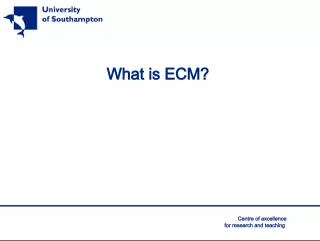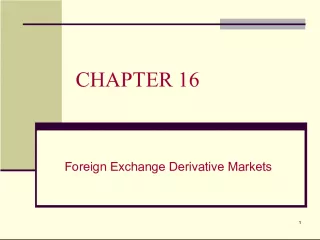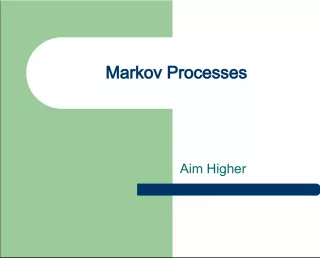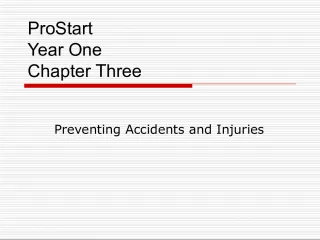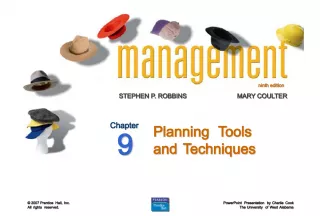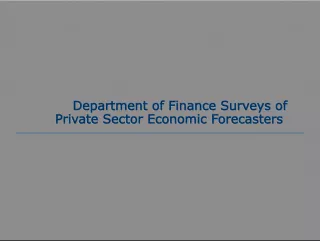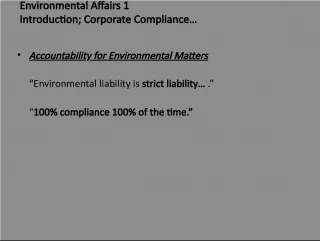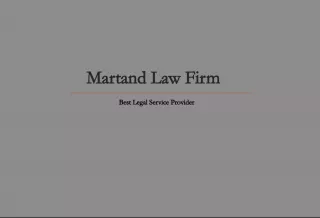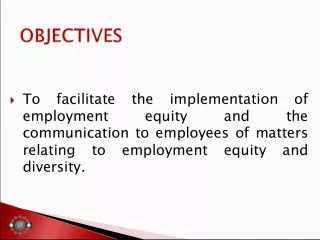Forecasting: Why It Matters and How to Do It
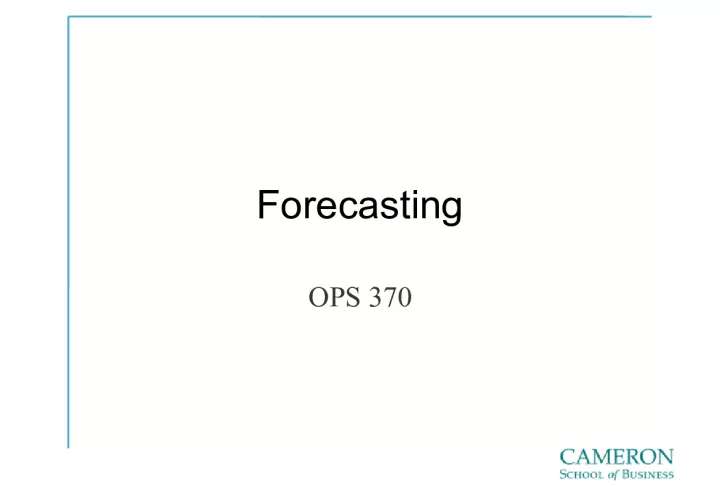

Learn the importance of forecasting in business planning and decision-making. Discover the different timeframes and types of data that can be used to make more accurate predictions.
- Uploaded on | 0 Views
-
 jan
jan
About Forecasting: Why It Matters and How to Do It
PowerPoint presentation about 'Forecasting: Why It Matters and How to Do It'. This presentation describes the topic on Learn the importance of forecasting in business planning and decision-making. Discover the different timeframes and types of data that can be used to make more accurate predictions.. The key topics included in this slideshow are forecasting, historical data, future events, biased, marketing, sales, demand, short-term, medium-term, long-term,. Download this presentation absolutely free.
Presentation Transcript
1. Forecasting OPS 370
2. Forecasting What is Forecasting? Determining Future Events Based on Historical Facts and Data Some Thoughts on Forecasts Forecasts Tend to Be Wrong ! Forecasts Can Be Biased ! (Marketing, Sales, etc.) Forecasts Tend to Be Better for Near Future So, Why Forecast? Better to Have Educated Guess About Future Than to Not Forecast At All! Forecasting - Chapter 4 2
3. What to Forecast? Forecasting - Chapter 4 3 Short Term (0-3 Months) Demand for Individual Products & Services Medium Term (3 Months 2 Years) Demand for Product & Service Families Long Term (>2 Years) Total Sales, New Offerings
4. How to Forecast? Qualitative Methods Based On Educated Opinion & Judgment (Subjective) Particularly Useful When Lacking Numerical Data (Example: Design and Introduction Phases of a Products Life Cycle) Quantitative Methods Based On Data (Objective) Forecasting - Chapter 4 4
5. Qualitative Methods Executive Judgment Sales Force Composite Market Research/Survey Delphi Method Forecasting - Chapter 4 5
6. Quantitative Methods Time Series & Regression Time Series Popular Forecasting Approach in Operations Management Assumption: Patterns That Occurred in the Past Will Continue to Occur In the Future Patterns Random Variation Trend Seasonality Composite Forecasting - Chapter 4 6
8. UK Airline Miles Thousands of Miles Observe: Increasing trend, Seasonal component. Random variation.
9. Forecasting Steps Forecasting - Chapter 4 9 Data Collection Data Analysis Model Selection Monitoring Collect Relevant/Reliable Data Be Aware of Garbage-In, Garbage Out
10. Forecasting Steps Forecasting - Chapter 4 10 Data Collection Data Analysis Model Selection Monitoring Plot the Data Identify Patterns
11. Forecasting Steps Forecasting - Chapter 4 11 Data Collection Data Analysis Model Selection Monitoring Choose Model Appropriate for Data Consider Complexity Trade-Offs Perform Forecast(s) Select Model Based on Performance Measure(s)
12. Forecasting Steps Forecasting - Chapter 4 12 Data Collection Data Analysis Model Selection Monitoring Track Forecast Performance (Conditions May and Often Do Change)
13. Time Series Models Short Term Nave Simple Moving Average Weighted Moving Average Exponential Smoothing Forecasting - Chapter 4 13
14. Forecasting Example L&F Bakery has been forecasting by gut feel. They would like to use a formal (i.e., quantitative) forecasting technique. Forecasting - Chapter 4 14
15. Forecasting Methods Nave Forecast for July = Actual for June F t+1 = A t F Jul = A Jun = 600 Forecast Very Sensitive to Demand Changes; Good for stable demand Forecasting - Chapter 4 15
16. Forecasting Methods Nave (Excel) Forecasting - Chapter 4 16 =C4 =C5
17. Forecasting Methods Moving Average Forecast for July = Average of June, May, and April F t+1 = ( A t +A t-1 +)/n F Jul = (600+500+400)/3 = 500 Values Equally Weighted; Good for stable demand; Sensitive to fluctuation; Lags Common application: Stock price forecasting
18. Forecasting Methods 30 Day Moving Average of AAPL Price
19. Forecasting Methods Moving Average (Excel) =AVERAGE(C4:C6) = AVERAGE(C5:C7)
20. Forecasting Methods Moving Average Example Assume n = 2 (125+175)/2 = 150 (175+150)/2 = 162.5 (150+150)/2 = 150 (150+160)/2 = 155
21. Forecasting Methods Weighted Moving Average F t+1 = ( W 1 A t +W 2 A t-1 +) Assume that W 1 = 0.5, W 2 =0.3 and W 3 = 0.2 F Jul = (0.5)(600) + (0.3)(500) + (0.2)(400) = 300 + 150 + 80 = 530 Typically Gives More Weight to Newer Data Lags; Sensitive
22. Forecasting Methods Weighted Moving Average =$G$6*C6+$G$5*C5+$G$4*C4 =$G$6*C7+$G$5*C6+$G$4*C5
23. Forecasting Methods Weighted Moving Average Example Assume n = 2, W 1 = 0.7, W 2 = 0.3 (0.7)(175) + (0.3)(125) = 160 (0.7)(150) + (0.3)(175) = 157.5 (0.7)(150) + (0.3)(150) = 150 (0.7)(160) + (0.3)(150) = 157
24. Forecasting Methods Exponential Smoothing Forecast for June = Forecast for May + (Forecast Error in May) is a constant between 0 and 1 Forecast Error = Difference Actual Demand and Forecasted Demand General Formula: F t+1 = F t + e t
25. Forecasting Methods Exponential Smoothing Assume that = 0.3 What is the forecast for July? = June Forecast + (Forecast Error in June) = 343 + (0.3)(257) = 420 Requires less data; Good for stable data
26. Forecasting Methods Exponential Smoothing (Excel) Initial forecast =D4+$G$4*(C4-D4) =D5+$G$4*(C5-D5)
27. Forecasting Methods Exponential Smoothing Example Assume = 0.4 (125) + (0.4)(175-125) = 145 (145) + (0.4)(150-145) = 147 (147) + (0.4)(150-147) = 148.2 (148.2) + (0.4)(160-148.2) = 152.9 Need initial forecast; Assume 125 (125) + (0.4)(125-125) = 125
28. Forecasting Methods How to Select Value of ? Alpha determine importance of recent forecast results in new forecasts Small alpha Less importance on recent results (Good for products with stable demand) Large alpha Recent forecast results more important (Good for product with varying demands)
29. Determining Forecast Quality How Well Did a Forecast Perform? Determine Forecast Error Error = Actual Demand Forecasted Demand Average Error 121.8
30. Determining Forecast Quality Why is Average Error a Deceiving Measure of Quality? Better Measures: Mean Absolute Deviation Mean Squared Error Root Mean Squared Error
31. Determining Forecast Quality MAD MSE Measure of Bias: Tracking Signal = Sum of Errors/MAD =731/131.8 = 5.55 *OK if between -4 and +4
32. Determining Forecast Quality For this MA(2) forecast. What is MAD, MSE, and TS?
34. Linear Trend Line Given Data Y = Values of Response Variable X = Values of Independent Variable Parameters to estimate a = Y-intercept b = slope Use least squares regression equations to estimate a and b . Or
35. Excel for Linear Regression Use SLOPE Function Use INTERCEPT Function
